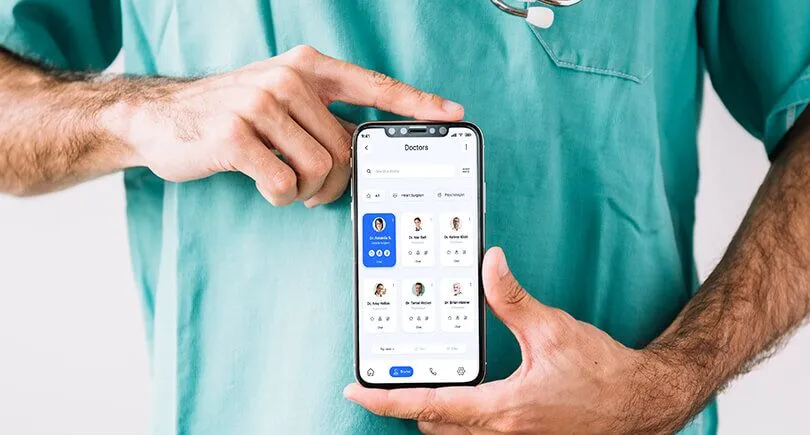Critical Mistakes to Avoid in Healthcare App Development
The intersection of healthcare and technology holds immense promise. Healthcare apps offer the potential to revolutionize patient engagement, streamline clinical workflows, improve diagnostics, and enhance overall well-being.
However, the path from concept to successful, widely-adopted healthcare application is fraught with unique challenges and potential pitfalls. Unlike standard consumer apps, failures here carry significantly higher stakes – impacting patient safety, violating stringent regulations, eroding trust, and wasting substantial resources.
For software development companies venturing into this critical domain, understanding and avoiding common mistakes isn’t just good practice; it’s an ethical and operational imperative.
While the landscape is complex, two foundational areas consistently trip up even well-intentioned projects: Regulatory & Security Missteps and Neglecting User-Centricity & Workflow Integration.
Must Read: Healthcare App Design Requirements and Trends
Mistake 1: Underestimating the Regulatory Maze and Security Imperatives
This is arguably the most common and potentially catastrophic category of error. Healthcare operates under a web of stringent regulations designed to protect patient privacy and ensure safety. Treating app development like any other consumer software project is a recipe for disaster.
- Ignoring HIPAA (and Beyond): The Health Insurance Portability and Accountability Act (HIPAA) in the US is the bedrock regulation, but it’s far from the only one. Developers often make the critical mistake of assuming HIPAA compliance is a simple checkbox or solely about encrypting data at rest. HIPAA compliance is a comprehensive framework covering the privacy (PHI handling), security (administrative, physical, and technical safeguards), and breach notification rules. It applies not just to covered entities (like hospitals and doctors) but also to their “business associates” – which includes app developers handling PHI.
- Misunderstanding the scope, failing to conduct a thorough Risk Analysis, neglecting proper Business Associate Agreements (BAAs), or inadequately managing data minimization can lead to severe penalties, lawsuits, and irreparable reputational damage. Furthermore, depending on the app’s function (e.g., diagnosis, treatment recommendations), FDA regulations (as a SaMD – Software as a Medical Device) or international equivalents like GDPR (for EU data), MDR/IVDR, or country-specific laws may apply. Assuming “one size fits all” for compliance is perilous.
- Inadequate Data Security Measures: Healthcare data is among the most sensitive personal information. Breaches are costly, both financially and in terms of patient trust. Common security missteps include weak or improperly implemented data encryption (both in transit and at rest), insecure API integrations that expose data, insufficient access controls allowing unauthorized users to view PHI, lack of robust authentication mechanisms (like weak passwords without MFA), and poor vulnerability management. Failing to design security from the outset (“security by design”) and relying on bolt-on solutions later is ineffective. Regular penetration testing, secure coding practices, and rigorous data storage policies (knowing exactly where every piece of PHI resides and how it’s protected) are non-negotiable. Remember the Target breach? Originated via an HVAC vendor’s access. Third-party libraries and SDKs within your app can be similar weak points if not vetted meticulously for security.
- Neglecting Audit Trails and Data Governance: Who accessed what data, when, and from where? Robust audit logging is crucial for HIPAA compliance and incident response. Failing to implement comprehensive, tamper-proof audit trails hinders breach investigations and compliance audits. Similarly, lacking clear data governance – defined policies for data collection, storage, retention, and destruction – creates risk. Collecting unnecessary data “just in case” increases the attack surface and compliance burden. Not having a clear, compliant path for patient data deletion requests (as mandated by regulations like GDPR and CCPA, even impacting US healthcare entities) is another frequent oversight.
The consequences here are severe: multi-million dollar fines, forced app shutdowns, loss of provider partnerships, shattered patient trust, and potentially, harm if PHI exposure leads to discrimination or other negative outcomes. Regulatory compliance isn’t a feature; it’s the bedrock upon which a viable healthcare app is built. Software companies must invest in deep expertise or partner closely with specialized compliance and legal professionals throughout the development lifecycle.
Mistake 2: Failing True User-Centricity and Clinical Workflow Integration
Many healthcare apps fail not because of technical flaws, but because they simply don’t resonate with or effectively serve their intended users. This encompasses both patients and healthcare professionals (HCPs). Building in a vacuum, driven solely by technology possibilities rather than human needs and real-world contexts, leads to low adoption and wasted potential.
The fallout here manifests as low download rates, poor user retention, negative reviews, and ultimately, apps that gather dust. For clinician tools, it can mean active resistance and workarounds that bypass the intended safety or efficiency benefits. Investing heavily in user research, iterative prototyping, and rigorous, context-specific usability testing pays dividends in adoption, effectiveness, and positive health outcomes.
The Synergistic Impact and Path Forward
While discussed separately, these two critical mistake areas – Regulatory/Security and User-Centricity/Workflow – are deeply interconnected. A beautifully designed, highly usable app that violates HIPAA is dead on arrival. A fully compliant, ultra-secure app that clinicians hate to use or patients can’t understand is equally doomed. Success requires harmonizing these imperatives.
- Security and usability can conflict: Strong authentication (like frequent MFA prompts) can frustrate users. Finding the right balance – ensuring robust security without creating unbearable friction – is a key design challenge requiring careful thought and user feedback. Compliance requirements might dictate certain data handling practices that impact the user experience; explaining these transparently to users is crucial.
- Regulations inform design: Understanding HIPAA’s minimum necessary standard should guide what data you ask for and display. Privacy regulations influence features like granular consent management and easy-to-access privacy notices within the app.
- Workflow integration enhances security: Pulling data directly from the EHR via secure APIs is often more secure and accurate than manual entry, reducing error risk. Automating data flow within established, secure systems minimizes insecure workarounds clinicians might otherwise create.
Must Read: Chronic Disease Management Software: 6 New Product Development Opportunities
Avoiding these mistakes requires a fundamental shift in approach for software development companies:
- Embrace Expertise: Partner with healthcare compliance specialists, security experts (experienced in healthcare data), clinical advisors, and UX researchers specializing in healthcare from Day One. Don’t try to wing it.
- Prioritize from the Start: Regulatory compliance, security, and user-centricity cannot be afterthoughts. They must be core pillars of the project plan, budget, and timeline, influencing every architectural and design decision.
- Adopt “Privacy & Security by Design“: Bake these principles into the software development lifecycle (SDLC) from requirements gathering through architecture, coding, testing, and deployment.
- Commit to Deep User Research & Testing: Go beyond surveys. Conduct ethnographic studies, in-depth interviews, and rigorous usability testing with real target users in realistic settings. Iterate relentlessly based on feedback.
- Plan for Integration Early: If targeting clinical use, engage with health IT departments and EHR vendors early to understand integration capabilities (FHIR APIs) and constraints. Design the app as part of the ecosystem, not an island.
- Foster Continuous Vigilance: Regulations evolve, security threats change, and user needs shift. Compliance, security patching, and user feedback loops must be ongoing processes throughout the app’s lifecycle.
Developing successful healthcare software is a complex, demanding endeavor. The cost of failure is measured not just in dollars, but in patient safety, trust, and well-being.
By rigorously avoiding the critical mistakes of underestimating the regulatory compliance and data security labyrinth and failing to achieve genuine user-centric design and seamless clinical workflows integration, software development companies can navigate the minefields.
The reward is not merely a functional app, but a transformative tool that earns trust, improves lives, and genuinely contributes to the future of healthcare. It demands diligence, specialized knowledge, and an unwavering commitment to putting the safety, privacy, and needs of patients and providers at the absolute center of every decision.














Post Comment